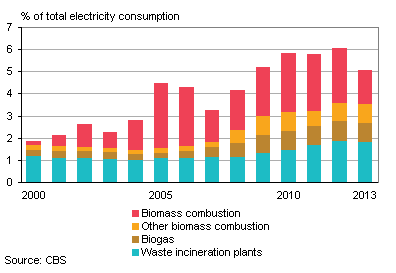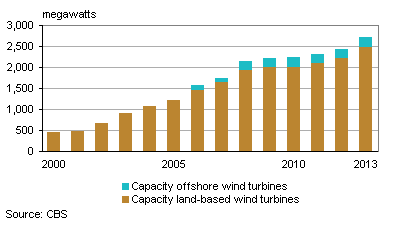Lower renewable electricity production

Last year, 11.8 billion kilowatt hours (kWh) of renewable electricity were generated, i.e. 10.1 percent of total electricity consumption in the Netherlands and 0.4 percentage points below the level in 2012. Electricity production from biomass decreased, but electricity generation by wind turbines increased.
Output renewable electricity

Reduced amount of biomass combusted in power stations
Generation of electricity from biomass fell by approximately one fifth, because the amount of biomass combusted in power stations was reduced by 40 percent. One of the reasons for the reduction was the fact that the subsidy scheme partly expired. Electricity generation from biomass by means of other technologies, e.g. waste incineration and biogas, remained stable.
Output renewable electricity from biomass

More electricity generated by wind turbines
Electricity generated by wind turbines grew by 8 percent in 2013 due to capacity expansion. The overall capacity of Dutch wind turbines rose by just nearly 300 megawatts in 2013 to approximately 2.7 thousand megawatts at the end of 2013. The capacity expansion was the result of the erection of several large wind farms partly financed by subsidies granted under the SDE scheme.
For the first time since 2008, the capacity of wind turbines has grown considerably. In 2013, 45 percent of renewable electricity was generated by wind turbines.
Capacity wind turbines

Largest capacity expansion in 2020
Two offshore wind farms with an overall capacity of 228 megawatts were built in the North Sea,. The capacity of land-based wind farms totalled approximately 2.5 thousand megawatts. The government aims to expand the capacity of land-based wind farms to 6 thousand megawatts in 2020 and the capacity of offshore wind farms is projected at 4.5 thousand megawatts in 2023.
Reinoud Segers and Marco Wilmer